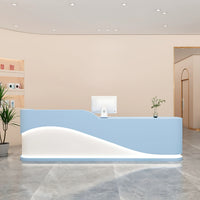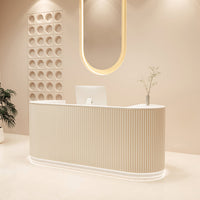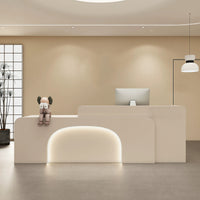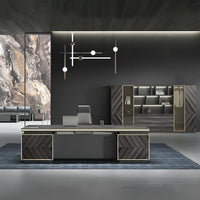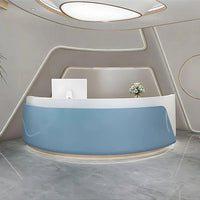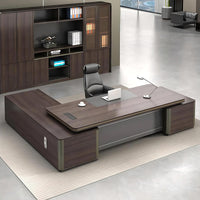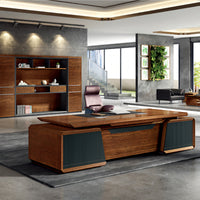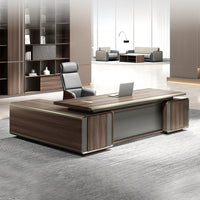How to Choose the Reception Desk for Offices?
kaguyasuContent Menu
● Introduction
● Understanding the Role of the Reception Desk
>> The Reception Desk as a Brand Ambassador
>> Functional Center of the Reception Area
● Key Factors to Consider When Choosing a Reception Desk
>> Size and Proportion
>>> Assessing Your Space
>>> Desk Height and Accessibility
>> Style and Design
>>> Matching Your Brand Image
>>> Color and Finish
>> Material Selection
>> Functionality and Features
>>> Storage Solutions
>>> Technology Integration
>>> Security Features
>> Ergonomics and Comfort
>>> Work Surface Height
>>> Space for Movement
>> Budget Considerations
>> Customization Options
● Types of Reception Desks
>> Straight Reception Desks
>> L-Shaped Reception Desks
>> U-Shaped Reception Desks
>> Circular or Curved Reception Desks
>> Modular Reception Desks
● Practical Steps for Selecting the Right Reception Desk
>> Step 1: Analyze Your Needs
>> Step 2: Evaluate Your Space
>> Step 3: Set a Budget
>> Step 4: Research Desk Options
>> Step 5: Involve Stakeholders
>> Step 6: Plan for Installation
● Mistakes to Avoid When Choosing a Reception Desk
>> Ignoring Ergonomics
>> Overlooking Storage Needs
>> Neglecting Visitor Experience
>> Failing to Plan for Technology
>> Underestimating Maintenance
● Trends in Reception Desk Design
>> Sustainable Materials
>> Integrated Technology
>> Custom Branding
>> Minimalist Aesthetics
>> Flexible Configurations
● Maintenance and Longevity
>> Cleaning and Care
>> Regular Inspections
>> Upgrading Components
● Frequently Asked Questions
Introduction
The reception area is the first point of contact for visitors, clients, and employees entering your office. A well-chosen reception desk not only serves a practical function but also creates a strong first impression, reflecting your company's brand, culture, and professionalism. Selecting the right reception desk involves considering a range of factors, from aesthetics and functionality to ergonomics and budget. This comprehensive guide will walk you through every aspect of choosing the perfect reception desk for your office, ensuring that your choice enhances both the look and efficiency of your workspace.

Understanding the Role of the Reception Desk
The Reception Desk as a Brand Ambassador
The reception desk is more than just a piece of furniture; it is a visual representation of your company's identity. The materials, design, and layout of the desk can communicate values such as innovation, tradition, creativity, or professionalism. For example, a sleek, minimalist desk may signal modernity and efficiency, while a classic wooden desk may convey stability and tradition.
Functional Center of the Reception Area
Beyond aesthetics, the reception desk is the central hub for administrative activities. It must facilitate the receptionist's tasks, including greeting visitors, answering calls, managing deliveries, and handling paperwork. The right desk will promote productivity, organization, and comfort for the staff working at it.
Key Factors to Consider When Choosing a Reception Desk
Size and Proportion
Assessing Your Space
Begin by measuring your reception area. The desk should be proportionate to the space—large enough to be functional and welcoming, but not so big that it overwhelms the room or impedes traffic flow. Consider the number of people who will be working at the desk and the expected volume of visitors.
Desk Height and Accessibility
Standard reception desks are typically between 42 and 48 inches high. Ensure the desk height is comfortable for both standing visitors and seated receptionists. If your office is required to comply with ADA (Americans with Disabilities Act) standards, make sure part of the desk is accessible to wheelchair users.
Style and Design
Matching Your Brand Image
Choose a desk style that complements your company's branding and interior décor. Common styles include:
- Modern: Clean lines, glass or metal finishes, and minimalist design.
- Traditional: Wood finishes, ornate details, and classic shapes.
- Transitional: A blend of modern and traditional elements.
- Industrial: Exposed metal, reclaimed wood, and utilitarian features.
Color and Finish
The color and finish of the desk should harmonize with the overall color palette of your office. Neutral tones are versatile and timeless, while bold colors can make a statement or reinforce brand identity.
Material Selection
Reception desks are available in a variety of materials, each with its own advantages:
- Wood: Warm, inviting, and classic; available in many finishes.
- Laminate: Durable, affordable, and easy to clean; mimics wood or stone.
- Glass: Sleek and modern; creates a sense of openness.
- Metal: Industrial and durable; often used as an accent or for structural elements.
- Solid Surface/Stone: Luxurious, durable, and easy to maintain.
Consider durability, maintenance requirements, and the impression each material conveys.
Functionality and Features
Storage Solutions
Receptionists need space to store office supplies, files, and personal items. Look for desks with built-in drawers, cabinets, and shelves. Cable management features are also important to keep the workspace tidy.
Technology Integration
Modern reception desks should accommodate computers, phones, printers, and other devices. Ensure there are grommets or cutouts for cables, as well as power outlets and USB ports if possible.
Security Features
If the reception area handles sensitive documents or cash, consider desks with lockable drawers or compartments.
Ergonomics and Comfort
Work Surface Height
The work surface should be at a comfortable height for typing and writing. Adjustable chairs and footrests can further enhance ergonomic comfort.
Space for Movement
Receptionists often need to move between the desk, filing cabinets, and other equipment. Ensure there is enough space behind and around the desk for easy movement.
Budget Considerations
Reception desks are available at a wide range of price points. Set a realistic budget that balances quality, durability, and design. Remember to factor in delivery and installation costs, as well as any customization fees.
Customization Options
If your office has unique requirements or branding needs, consider a custom-designed reception desk. Customization allows you to select specific materials, finishes, dimensions, and features to perfectly suit your space.
Types of Reception Desks
Straight Reception Desks
These are simple, linear desks that fit well in small or narrow spaces. They are easy to install and ideal for offices with limited reception areas.
L-Shaped Reception Desks
L-shaped desks provide more workspace and storage, making them suitable for busy reception areas or where multiple staff members share the desk.
U-Shaped Reception Desks
U-shaped desks offer maximum workspace and are ideal for large offices with high visitor traffic. They provide ample surface area for technology, paperwork, and storage.
Circular or Curved Reception Desks
Curved desks create a welcoming atmosphere and are visually striking. They are often used in modern or high-end office environments.
Modular Reception Desks
Modular desks can be configured in various shapes and sizes, offering flexibility for growing offices or changing needs.
Practical Steps for Selecting the Right Reception Desk
Step 1: Analyze Your Needs
Consider the following questions:
- How many receptionists will use the desk?
- What tasks will be performed at the desk?
- What equipment and storage are required?
- How many visitors do you expect at peak times?
Step 2: Evaluate Your Space
Measure the reception area, noting the location of doors, windows, and electrical outlets. Sketch a floor plan to visualize different desk options.
Step 3: Set a Budget
Determine your budget, including potential costs for delivery, installation, and customization.
Step 4: Research Desk Options
Browse catalogs and visit showrooms to compare styles, materials, and features. Consider both ready-made and custom options.
Step 5: Involve Stakeholders
Consult with reception staff, office managers, and interior designers to ensure the desk meets practical and aesthetic needs.
Step 6: Plan for Installation
Ensure the chosen desk can be delivered and installed without difficulty. Check for elevator access, doorway widths, and any potential obstacles.
Mistakes to Avoid When Choosing a Reception Desk
Ignoring Ergonomics
A desk that looks great but is uncomfortable can lead to decreased productivity and even health issues for staff. Always prioritize ergonomic design.
Overlooking Storage Needs
Insufficient storage can result in a cluttered, disorganized reception area. Plan for adequate drawers, shelves, and cabinets.
Neglecting Visitor Experience
The reception desk should be inviting and accessible to visitors. Avoid designs that create barriers or seem unwelcoming.
Failing to Plan for Technology
Modern offices rely on technology. Ensure the desk has provisions for computers, phones, and cable management.
Underestimating Maintenance
Some materials require more upkeep than others. Choose finishes that are easy to clean and maintain, especially in high-traffic areas.
Trends in Reception Desk Design
Sustainable Materials
Eco-friendly materials such as reclaimed wood, bamboo, and recycled metal are increasingly popular, reflecting a commitment to sustainability.
Integrated Technology
Desks with built-in charging stations, wireless charging pads, and touchless check-in systems are becoming standard in modern offices.
Custom Branding
Companies are personalizing reception desks with logos, brand colors, and unique design elements to reinforce their identity.
Minimalist Aesthetics
Clean lines, uncluttered surfaces, and neutral color palettes create a calming and professional environment.
Flexible Configurations
Modular desks that can be reconfigured as office needs change are gaining popularity, especially in dynamic work environments.
Maintenance and Longevity
Cleaning and Care
Follow manufacturer guidelines for cleaning and maintaining your reception desk. Use appropriate cleaners for wood, glass, or metal surfaces.
Regular Inspections
Periodically inspect the desk for signs of wear, loose hardware, or damage. Address issues promptly to prolong the desk's lifespan.
Upgrading Components
As technology evolves, consider upgrading cable management systems, adding charging ports, or refreshing the desk's finish to keep it current.

Frequently Asked Questions
Q1: What size reception desk is best for a small office?
A: For small offices, a straight or compact L-shaped desk is ideal. It should provide enough workspace for essential tasks without overwhelming the room. Measure your space carefully and choose a desk that allows for comfortable movement and visitor access.
Q2: How do I ensure my reception desk is accessible to people with disabilities?
A: Choose a desk with a section that is 28–34 inches high to accommodate wheelchair users. Ensure there is enough knee clearance and that the approach is unobstructed. Compliance with ADA guidelines is essential for public-facing offices.
Q3: What materials are most durable for a high-traffic reception area?
A: Laminate, solid surface, and metal are highly durable and easy to maintain. These materials resist scratches, stains, and daily wear, making them suitable for busy environments.
Q4: Can I customize a reception desk to match my company's branding?
A: Yes, many manufacturers offer customization options, including specific colors, finishes, logos, and unique design elements. Custom desks can be tailored to your exact specifications for a cohesive brand image.
Q5: How much should I budget for a quality reception desk?
A: Prices vary widely based on size, materials, and customization. Basic desks may start around a few hundred dollars, while high-end or custom designs can cost several thousand. Factor in delivery and installation when setting your budget.
Q6: How do I maintain and clean my reception desk?
A: Use manufacturer-recommended cleaners for the desk's material. Avoid abrasive products that can damage the finish. Regularly wipe down surfaces, check for loose hardware, and address any damage promptly to extend the desk's life.
Q7: What features should I look for to support receptionist productivity?
A: Look for desks with ample storage, integrated cable management, and ergonomic design. Features like lockable drawers, adjustable work surfaces, and easy access to technology can enhance productivity and organization.
---
Hot Tags: China, Global, OEM, private label, manufacturers, factory, suppliers, manufacturing company
